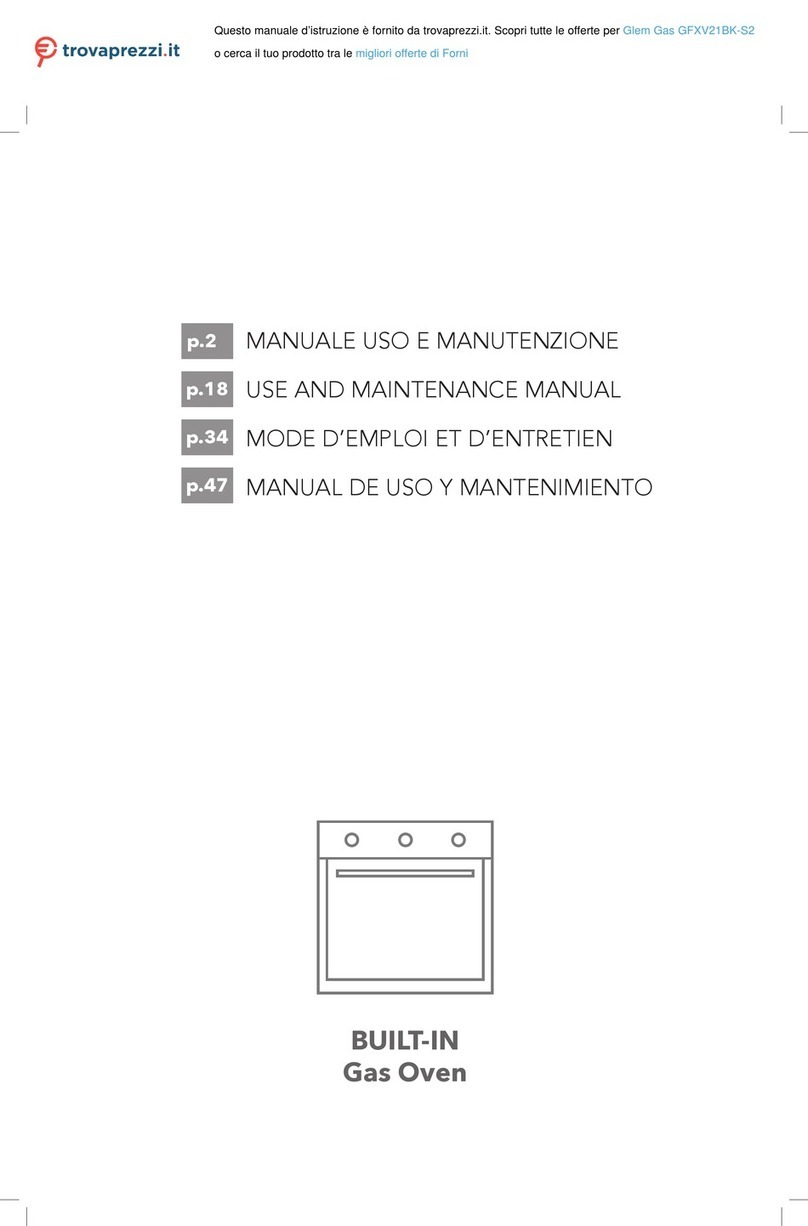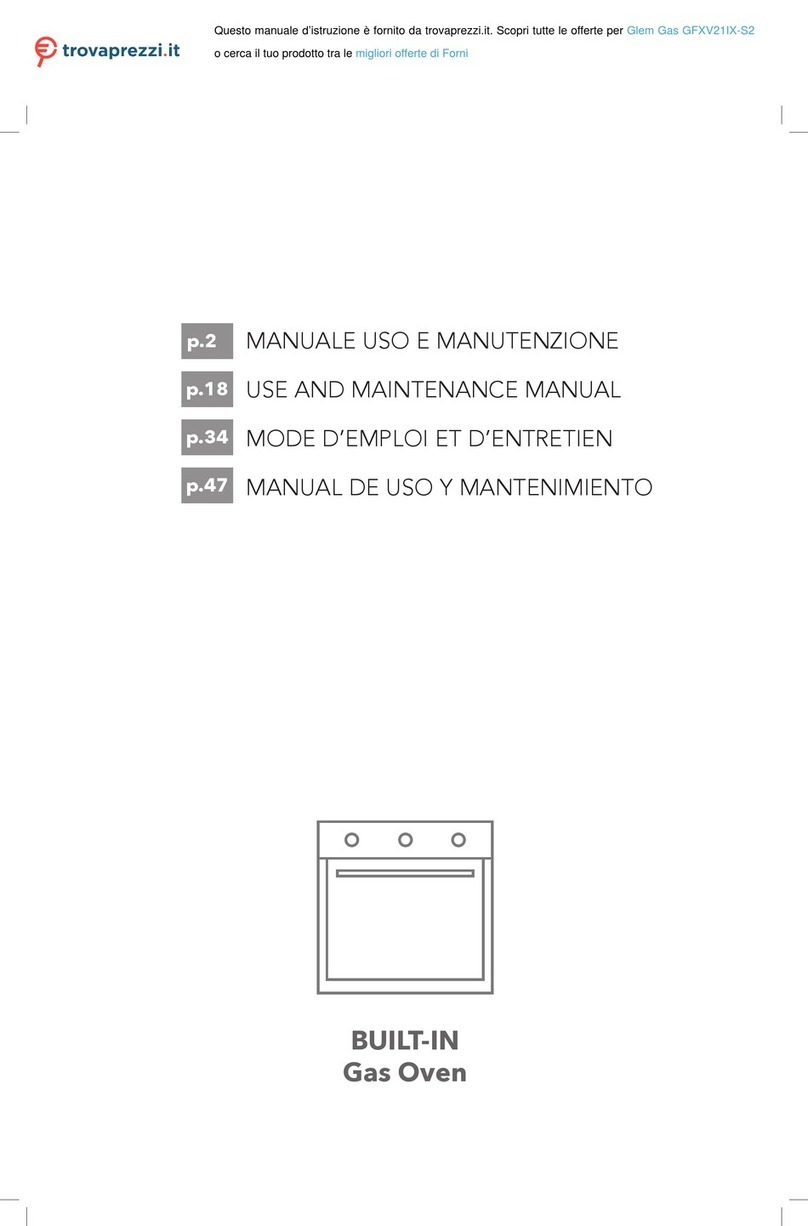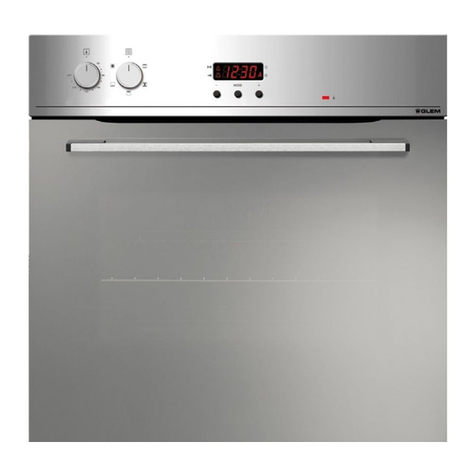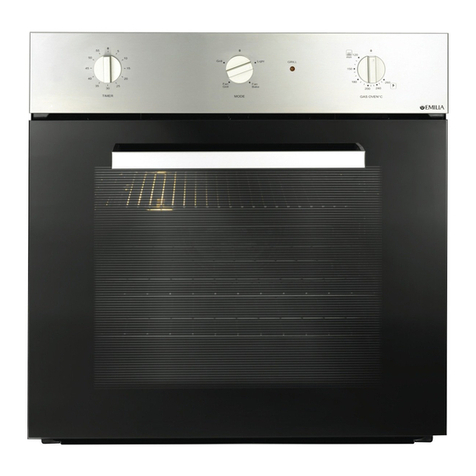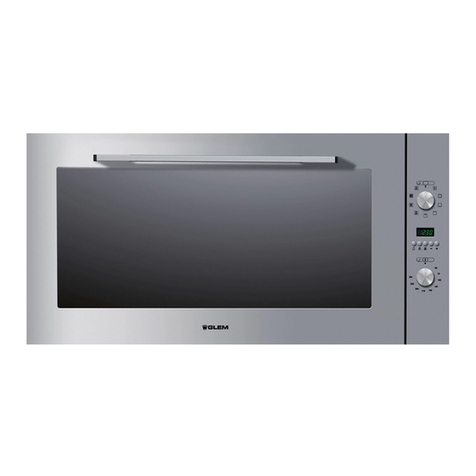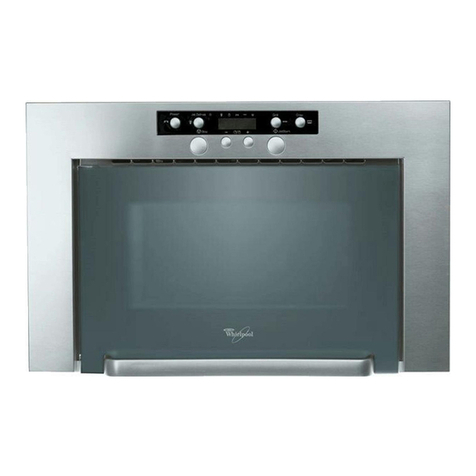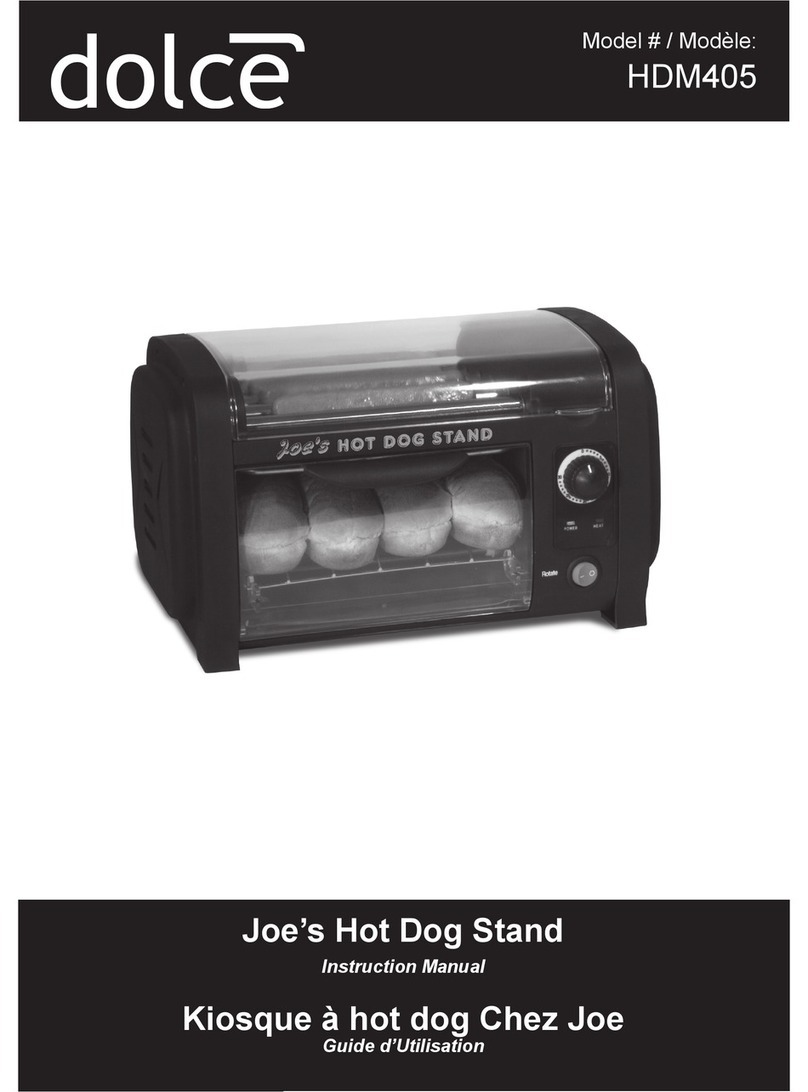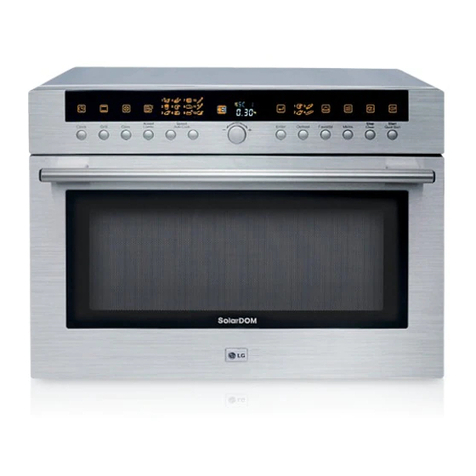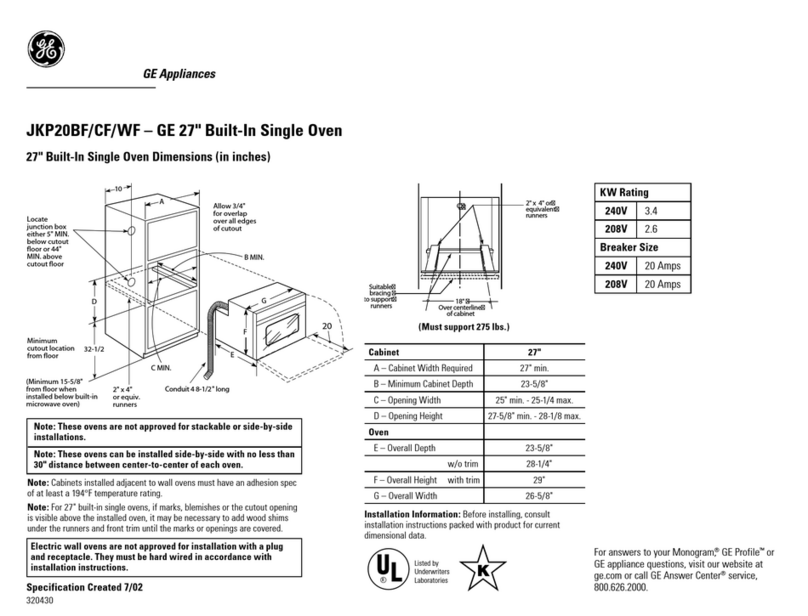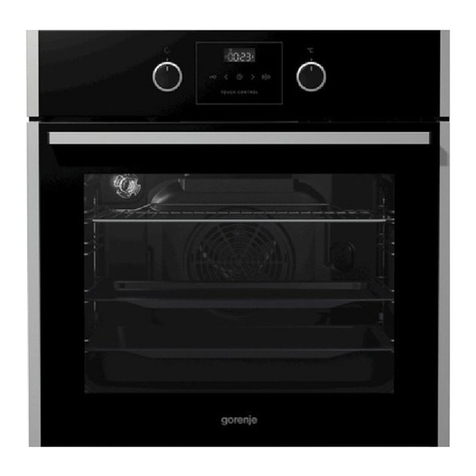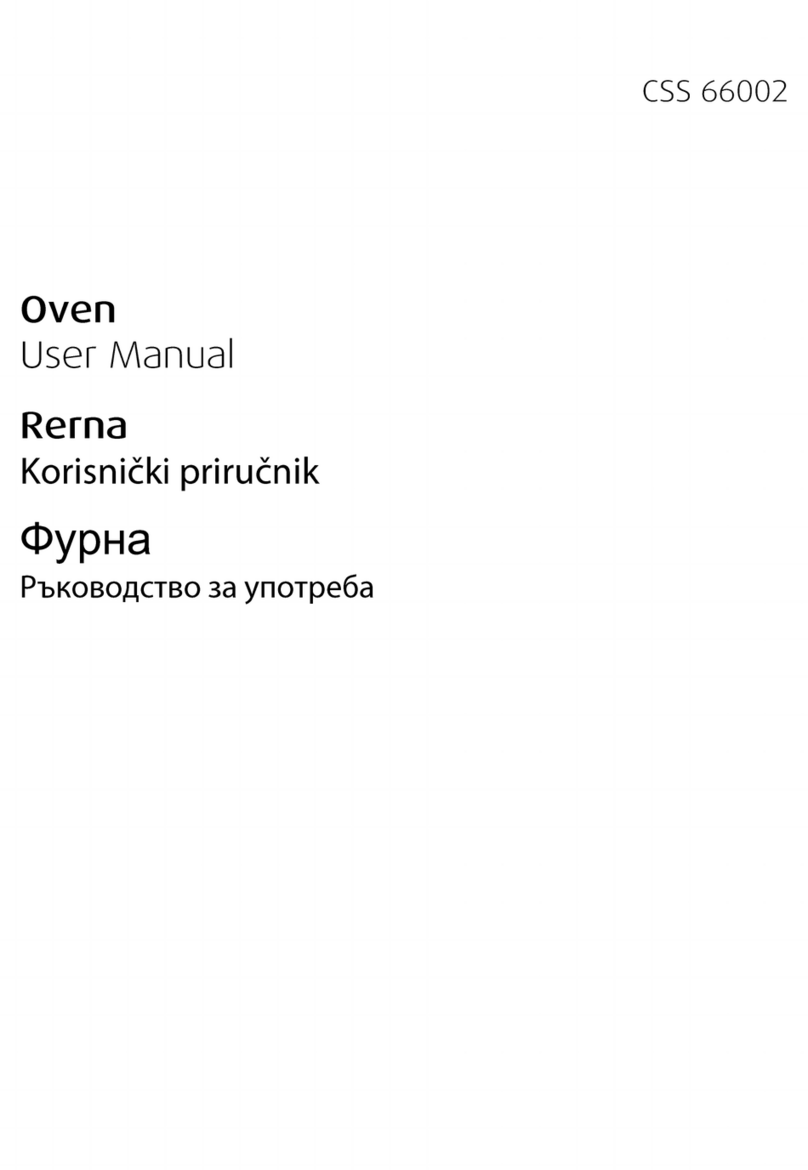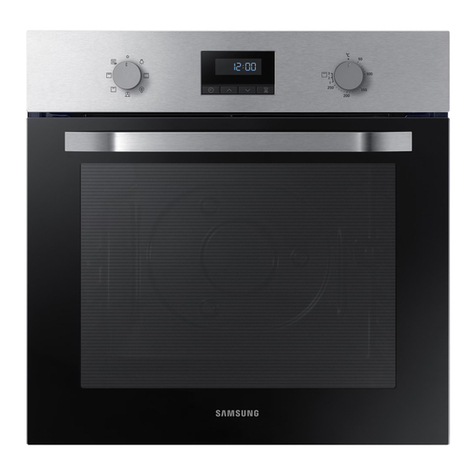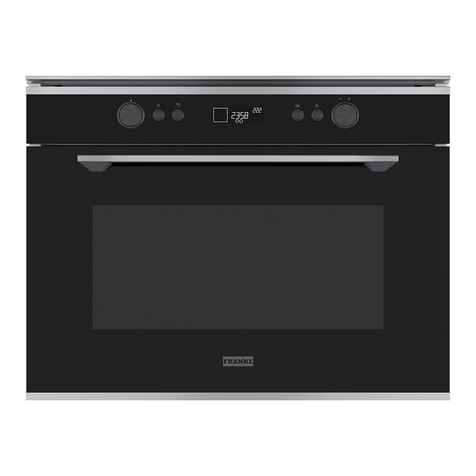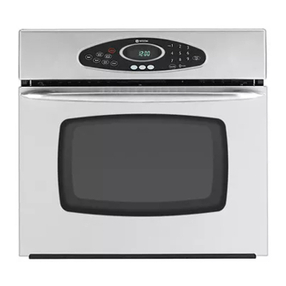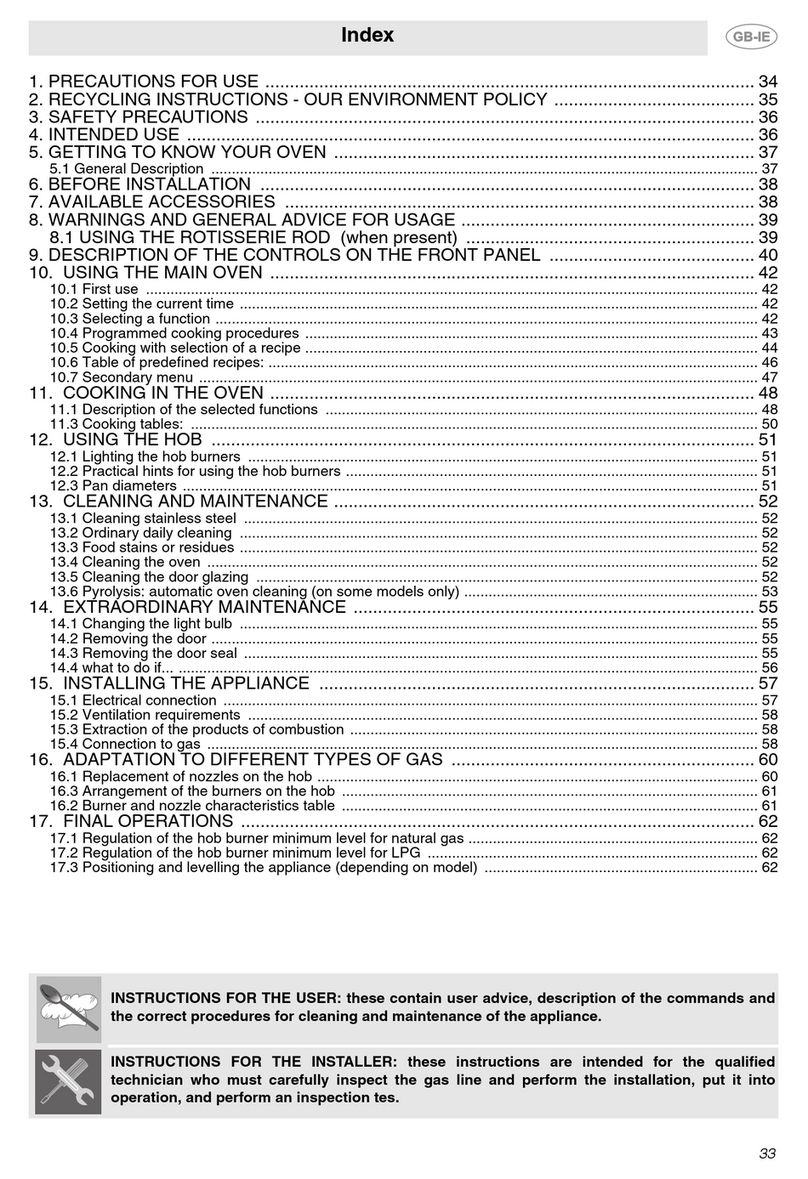Glem GF64GEI Quick guide

EDIT241121
INSTALLATION AND
INSTRUCTION MANUAL
Gas and Electric 60cm Built in Ovens
Models:
Glem - GF64GEI, GF64EEI
Emilia - EMF61MVI, EF64EI
IMPORTANT
This oven is for domestic applications. It is NOT suitable for commercial applications
of any kind. Do not install the oven if there is any doubt. Contact Glem Gas Australasia
if you require clarification.
This oven must be installed by a qualified and licensed installer in accordance with
these instructions. If you do not retain proof of correct installation your warranty will be
voided.
If your oven is found to be incorrectly installed you will be liable for all service costs. If
a warranty call is made and the oven is found to be incorrectly installed you will be
charged for the cost of the service even if the oven is not repaired. We will not service
an incorrectly installed oven.

2
Dear Customer,
Thank you for purchasing our product. This manual has been written to
assist you and instruct you in the operation of your oven. It will help you
get the best performance and make full use of the features of your oven.
The safety precaution and warnings are listed for your safety and the
safety of others when operating your oven. Please keep this manual in a
safe place for future reference.
This oven has been designed for use in cooking of domestic (household)
food. Any form of usage other than cooking food is considered dangerous
and inappropriate. The manufacture accepts no responsibility in the event
problems caused by improper use, incorrect use or faulty installation. A
signed installation certificate indicating the installers licence number and
details is required for warranty service.
OVEN SHOULD NOT BE USED IN A COMMERCIAL ENVIRONMENT
This includes semi commercial, commercial or communal applications
such as clubs and schools.
NOTE: Model number details are on the inside of the door. Record them
here for your records.
Model:
Serial No.:
Emilia and Glem ovens are manufactured in the Glem Gas factory in
Modena, Italy. They have been designed and constructed to meet the
following Australian Safety Standards:
AS/NZ 5263.0: 2017 (Amendment 1)
AS/NZ 5263.1.1: 2020
AS/NSZ 1044 -
Electromagnetic Compatibility Requirements.
Surface temperatures for all components comply with the standards. Even
so certain parts of an oven become very hot during and after use. A
cooling fan operates during the cooking cycle and afterwards until the
oven cools.

3
SAFETY HINTS AND USAGE TIPS
1) OVEN DOOR
Keep children away from the glass oven door while cooking is in progress:
if touched, the glass could cause burns. Don’t let children sit on or play
with the oven door. Do not use the drop-down door as a stool to reach
above cabinets. Do not rest baking dishes or put any weight on the oven
door.
2) GRILL - ALL MODELS
The grill is electric. Grilling must always be done with the oven door
closed.
3) USE OF POT HOLDER GLOVES - ALL MODELS
Make sure that burners and oven trays are cool before touching them
unless you are wearing oven gloves.
4) DO NOT MODIFY THIS OVEN
Do not modify or attempt to modify the technical characteristics of this
oven, as this may present a danger to you and those around you.
5) USE THE CORRECT COOKING VESSELS
For cooking food, use only plates and trays resistant to high temperatures.
6) DO NOT LINE THE OVEN WALLS OR FLOOR WITH FOIL
Never place aluminium foil directly on the oven racks, floor or wall as the
accumulated heat may damage the surface.
7) KEEP YOUR OVEN CLEAN
To avoid flare ups or fires within your oven we suggest keeping the oven
cavity as clean possible. Particularly after roasting something such as a
chicken we recommend wiping the oven out thoroughly. Place a tray of
water on a lower shelf to assist in reducing fat build ups.
8) PREHEAT FIRST
Preheating the oven first before starting cooking is advised. On a gas oven
there is no indicator light. A gas oven will reach 200C after 10-12 minutes.

4
GENERAL WARNINGS
•This oven must not be used by persons (including children) whose
physical, sensory or mental capacities are reduced or by persons
without experience or instruction, unless under supervision of a
responsible person or with appropriate instruction on the use of the
oven.
•Young children should be supervised to ensure they do not play with
the oven.
•WARNING: Accessible parts may become hot during use. To avoid
burns young children should be kept away.
•DO NOT USE polyunsaturated oils with cooking in the oven. The type
of oil can cause heavy deposits inside the oven.
•DO NOT USE a steam cleaner to clean the oven or use any caustic
cleaners to clean the oven.
•DO NOT use harsh abrasive cleaners or sharp metal scrapers to
clean the oven door since they can scratch the surface, which may
result in shattering of the glass.
•DO NOT spray aerosols near this oven while it’s operating.
•During use the oven becomes hot. Care should be taken to avoid
touching heating elements inside the oven. Please keep children
away from the oven.
•DO NOT store flammable materials in the oven.
•ALWAYS keep the oven clean to avoid fires
•After having used the oven, ensure that all knobs are in the OFF
position.
•This oven is unsuitable for use in marine craft, caravans, or mobile
homes.
•DO NOT USE AS A SPACE HEATER
•If the oven fails to operate correctly, call Glem Gas Australasia Pty Ltd
or their appointed agent for service. DO NOT ATTEMPT REPAIRS
YOURSELF.
Glem Gas Australasia Pty. Ltd. does not accept any responsibility for damage caused by
inappropriate, incorrect, and irrational use. For detailed information, refer to the Warranty
Card. Contact Glem Gas Australasia Pty. Ltd. on 1 300 307 917 for all service enquiries.
On websites
www.glemgas.com.au
and
www.emiliaappliances.com.au
you will find details of
our latest products and a source of useful and additional information.
With a view to continuously improving our products, we reserve the right to make
modifications to their technical, functional or aesthetic characteristics in parallel with
technological developments.

5
BEFORE USING FOR THE FIRST TIME
Remove all packing material and literature from the oven before
connecting the gas and electricity supplies.
Make sure all plastic has been removed before use. Some models have
trays with a protective coating; make sure the plastic coating has been
removed. Clean the interior of the oven and all accessories with soap and
water and dry them carefully.
Switch on the empty oven on maximum to eliminate grease residues from
manufacturing. There may be a slight odour at this time. Run the oven on
maximum for a period of 1 hour and open the kitchen windows to
ventilate. If this odour lingers use the oven and the odour will dissipate.
The oven is fitted with 4 guides for
positioning trays and racks at different
heights.
The oven comes with 2 RACKS:
Used to support containers for cooking food.
The oven comes with a grill tray and rack insert:
Removing & Installing the Oven Shelves
1. The shelves in your oven have been designed with safety stops.
2. Slide the oven shelves towards you until they reach the front stop
tilt them up at the front to clear the side supports and lift them
clear. To install them reverse the procedure.

6
GAS OVEN
DESCRIPTION OF CONTROLS
Use the controls and knobs on the oven instrument panel to select the
various functions.
‘TIMER’:
Minute counter – rotate the knob to the desired time up to 60
minutes and a bell will ring at the end of the time period. For very short
time periods turn the knob past the point you want and then back to it to
load the timer mechanism.
Some models may have an electronic timer.
Refer to electronic timer instructions in this book.
‘MODE’:
Function selector – selects the oven functions.
Position 0: Light off. The oven functions in Classic Bake mode
without the light - low power consumption baking.
Classic bake:
The oven operates without fan assistance, light on.
Fan Bake:
Oven operates with fan assistance. Light on.
Fan Grill:
The electric grill operates with the fan assistance. Leave
the door closed while grilling.
Grill:
The electric grill operates without fan assistance. Leave
the door closed while grilling. “Grill” indicator light
operates when grilling.
‘GAS OVEN’:
Selects the temperature most suitable to the specific
cooking requirements. The oven is equipped with a gas thermostat. Its
purpose is to keep the temperature as a constant heat. The oven is fitted
with electronic spark ignition and a safety gas shut off device that shuts of
the gas if the flame fails for any reason. Top position 0 switches the oven
off.

7
GAS OVEN
OVEN OPERATION
Lighting the Gas Oven
The oven burner must be ignited with the DOOR OPEN. There is a safety
device which prevents the oven lighting unless the door is in the open
position
1. Open the oven door and remove the grill tray and leave it out.
2. Press the ‘GAS OVEN’ knob and rotate it anti-clockwise to the
maximum setting. The electronic ignition is activated automatically
when the knob is depressed.
3. Keep knob depressed for about 15 seconds after the flame has
lit. Always view the flame during the lighting procedure for safety.
There is a hole in the base for viewing the burner.
4. Release the knob and select the desired temperature. Wait a
minute and close the door gently.
The oven burner is fitted with a safety valve which blocks the gas supply if
there is a failure in igniting the burner or if the flame is extinguished.
Manual Lighting of the Oven
In case of ignition malfunction or an electricity failure depress and rotate
the ‘GAS OVEN’ control knob in an anti clockwise direction to reach the
maximum temperature. Keep the knob depressed while lighting.
Light a match and place it into the hole in the base plate. Once the burner
has lit keep the knob depressed for 15 seconds.
When lighting the oven for the first time – if the electronic ignition fails to
light the oven – light the oven manually and run the oven by running it in at
200 degrees for 20 minutes. This will burn in the burner and remove any
moisture that may have prevented the oven from lighting electronically.
OVEN PREHEATING
Once the oven is lit set the oven knob to the required temperature and
wait for about 20 minutes before introducing the food. Comply with the
cooking indication chart in these instructions and to get the best out of the
oven choose the right shelf position.
On a gas oven there is no
temperature indicator light.

8
ELECTRIC OVEN
DESCRIPTION OF CONTROLS
Electric ovens have the advantage of being able to offer different types of
heat to suit many cooking applications. Models vary according to the
functions available.
TIMER:
Minute counter – rotate the knob to the desired time up to 60
minutes and a bell will ring at the end of the time period. For very short
time periods turn the knob past the point you want and then back to it to
load the timer mechanism.
Some models may have an electronic timer.
Refer to electronic timer instructions in this book.
‘MODE’:
Function selector – selects the oven functions. The oven
functions vary for each model.
‘TEMP’:
This thermostat pilot light switches on and off during cooking to
show that the heating cycles are taking place properly. For Static and fan
forced mode, the oven must always be preheated. For optimum results,
try to open the oven door as little as possible, opening the door lowers the
temperature suddenly and affects the thermostat cycles. When cooking
on different shelves simultaneously, put all containers in the centre of the
shelves.
‘OVEN’:
The oven temperature is controlled by a thermostat. Select the
required temperature for the cooking task. The indicator light goes out
when the temperature is reached.
OPERATING THE OVEN
Remove the grill tray. Choose a function using the MODE switch. Turn it to
the symbol of the cooking function you wish to use. Then rotate the
thermostat knob to the desired temperature. Wait until the thermostat
indicator light goes out. This indicates that the oven has reached
temperature. Then introduce the food to be cooked. Over the page is a
description of the functions that may be on your oven.

9
OVEN FUNCTIONS – Electric Oven (functions vary according to model)
FAN FORCED: The heat is generated by a circular element and
distributed by a fan. Fast and efficient and allows for baking on
more than one shelf. Some foods may need to be rotated using
this function.
ELECTRIC GRILL: On some models this is the inner part of the
upper element. Always grill with the door closed. Recommended
operation is for 30 minutes only, great for toasting, browning
foods etc.
FAN ASSISTED GRILL: A fan operates with the grill ideal for
cooking thicker cuts of meat. Great for steaks. Always grill with
the door closed.
DEFROST: Fan operates which shortens defrosting times.
PREHEAT: A time saving function that quickly preheats the oven to
a preset 160C. You can then set your desired cooking function.

10
COOKING TABLE
Dish
Shelf Position 1=top
Temp Degrees C
Cooking Time
Cakes
Static
Fan Oven
Static
Fan Oven
Minutes
Chocolate cake
Creme Caramel
Cup Cakes
Fruit Cake
Jam Tarts
Nut Cake
Scones
Sponge Cake
Swiss Roll
2
3
1
3
2
3
1
2
2
2 3
2 3
1 2
2 3
2 3
2 3
1 2
2 3
2 3
180-190
130-150
190-200
175-190
185-200
190-200
190-230
195-210
195-200
180
130
180-190
165-180
185-200
180-190
180-190
185
185-200
35-40
30-35
18-20 (35 cakes)
35-35
40-50
40-45
17 (35 scones)
35-45
35-45
Pastries
Brioches
Cookies
Pastry
Puff Pastry
3
2
3
3
2 3
2
2 3
2 3
190-200
180
220-240
230-250
180-190
165
190-220
200-230
25-30
20
18
10-15
Pizza and Bread
Bread
Muffins
Pizza
3
3
2
3
2
2
215-230
205-220
215-230
215-230
185-200
195-210
40-50
25-35
20-30
Baked Pasta
Lasagne
Macaroni
Pasta Bake
Vegetable bake
Baked in foil
Fillets or steak
Roast
Stewed fish
2
2
2
2
2
2
2
2
2 3
2 3
2 3
2 3
1 2 3
1 2 3
1 2 3
1 2 3
185-200
225-240
225-240
185-200
215-230
175-190
195-210
180-190
165-180
200-205
200-205
165-180
195-210
155-170
175-190
165-180
30-40
35-45
35-45
30-40
20-25
15-20
25-30
15-20
Roast Meats
Beef 1kg
Lamb 1kg
Pork 1 kg
Veal 1 kg
3
3
3
3
2 3 4
2 3 4
2 3 4
2 3 4
220-250
190-220
190-220
190-220
200-220
180-200
180-200
180-200
50-60
50-60
60-80
60-80
Roast Poultry
Chicken
Duck
Goose
Turkey
3
3
3
3
2 3 4
2 3 4
2 3 4
2 3 4
205-215
210-220
210-220
215-230
195-210
195-210
195-210
195-210
40
120-180
120
220
Roast Game
Rabbit
Venison
Pheasant
3
3
3
2 3 4
2 3 4
2 3 4
215-235
190-220
205-215
200-220
180-200
195-210
40
50-60
40-50

11
Cooking Notes:
•The information provided is purely a guideline. Modify to suit
experience, eating habits and personal taste.
•The times indicated in the table do not include preheating of the
oven, which is always recommended.
•The time and temperature indicated refer to average quantities of
food: meats1/1.5kg, dough for confectionery, pizza, bread 0.5/0.8kg.
•Information in brackets about shelves indicates the shelf to be used
when cooking several dishes together.
•When cooking on different shelves simultaneously put all containers
in the centre of their shelves.
NOTE: All ovens are different and your new oven may perform differently
to your previous model.
Shelf positions and operating temperatures may vary to what you are
accustomed. It sometimes takes a few uses to become fully familiar with
the characteristics of your new oven.
COOLING FAN FEATURE
Our ovens have a cooling fan that continues to run after the end of the
cooking cycle. The fan will stop once the residual heat in the oven has
dissipated.
It assists in keep the outside of your oven cool and prevents damage to
surrounding surfaces.

12
BAKING TROUBLE SHOOTING
All ovens are different and it can take some time to learn the cooking
characteristics of your new oven. Listed below are some common
problems, causes and suggested solutions that may assist.
Problem
Cause
Solution
Cooking unevenly
Wrong location in oven
Wrong size tray
Heat variations in oven
Use shelf to place food in centre of oven
Try alternatives
Turn food while cooking
Burning on top
Oven not preheated
Aluminium foil in oven
Food too close to top of oven
Turn oven on and wait for oven to reach temperature
before placing food in the oven
Remove foil
Place on a lower shelf
Burning on bottom
Temperature too high
Baking tins too large
Baking tins are dark coloured
Food too low in the oven
Opening the door too
frequently
Lower the temperature
Use correct sized tins or reduce temperature
Use light coloured tins or reduce temperature
Raise to a higher shelf position
Do not open the door too often while cooking
Meat and potatoes not
browning
Poor heat distribution on food
Try to place the food on a rack to allow the heat to
distribute evenly around the food
Cakes have hard split
crusts and appear over
cooked
Temperature too high
Food too high in the oven
Cake tin too deep
Cake tin a dark colour
Lower the temperature
Use a lower shelf position
Use correct size tin
Use a light coloured tin
Cakes sunk in centre
and seem under
cooked
Temperature too low
Cooking time is too short
Door opened too early
Increase temperature
Increase length of cooking time
Do not open door until late in the cycle
For more ideas and information go to www.glemgas.com.au
GRILL OPERATION – NOTE: Electric grill on all models
The grill is operated by the ‘MODE’ control knob. The oven door must be
closed during grill operation. The grill element is an infrared type, which
provides an even controlled heat.
Always grill with the oven door closed - the oven and grill cannot be
operated at the same time.
NOTE: If the oven thermostat knob is turned accidently during the
operation of the electric grill, a safety device will switch off
the grill.

13
GRILLING TIPS:
•Before introducing food inside the oven it is advisable to pre-heat the
oven for at least 5 minutes.
•Place the food to be grilled on the appropriate rack or tray, positioning
it at the highest level depending on the volume of food and the
amount of direct heat you want to apply.
•Place a dripping pan in the bottom compartment of the oven to collect
fats.
•Using a standard shelf with a drip tray below filled with some water will
avoid smoke build-up coming from burnt fat and at the same time
assist in keep the food moist.
•Depending on the type of food cooked (meat, fish, poultry, etc.), it is
necessary to turn it over to expose both sides to the heat from the
elements.
•The grilling process should not exceed 30 minutes.
USING THE ELECTRONIC TIMER (some models)
Setting the Clock
When the oven is first connected, or after a power failure, ‘0.00’ will flash
on the display. To set the clock, push the middle set button and the (+) or
(–) buttons immediately to the desired time. The time of day will be saved
after 10 seconds.
Using the Timer
The timer can be set for a maximum period of 99 minutes and a minimum
of 10 seconds.
To set the timer just push the (+) or (-) button until you have set the
required time in minutes and seconds.
When the timer is operating the timer on indicator will be lit.
Once the pre-set time has elapsed, the timer will beep Push the SET
button to switch off.
The (–) button can also be used to change the volume of the beep.

14
CLEANING AND MAINTENANCE
WARNING: the oven must be kept clean, as a build-up of fat constitutes a
fire risk.
1. Cleaning of Stainless Steel: In order that your oven retains its new
appearance, care should be taken to protect the stainless steel finish.
Never use gritty or abrasive sponges. We highly recommend stainless
steel cleaners and protectors. Stubborn stains can be removed by
soaking in hot water and stains can be prevented by using a clean cloth
soaked in soapy water before a spillage becomes cold or dries up. Acid
materials like milks, vinegar, citrus juice can damage the most resistant
surfaces. If a spill occurs wipe it up immediately.
2. Oven Cleaning: Oven spills should be cleaned straight away. Leaving
them will cause burning and smoking inside the oven the next time it is
used. Leaving spills can also cause permanent damage to the enamel and
make it extremely hard to remove later. A non-caustic cleaner should be
used such as non-caustic “Mr. Muscle” to clean the chamber of the oven.
Don not use caustic cleaners. Do not use abrasive scourers, sponges or
cleaning products. Wipe the oven out regularly while the oven is still warm
using hot soapy water and a soft cloth. The removal of the side supports
makes cleaning easier.
3. Cleaning of Oven Door - All models: The inner door glass is held in by a
bracket at the top of the door. This can be removed and the glass slid out
to allow cleaning in between the sheets of glass. With the glass removed
the tension in the hinges will cause the door to slam closed so be sure to
hold the door handle. The glass can be soaked in hot soapy water or
special glass cleaners. The outer glass should be cleaned with a specific
glass and mirror cleaner. Soapy water may leave streaks.
4. Removal of Side Shelf Supports - All models: The side racks are
removed by simply flexing the bottom rail off the support and unhooking at
the top. To replace just reverse the procedure.
5. Grill Element/Top Element - All models: This element must never be
sprayed with any detergents. A damp cloth and a bottlebrush can be used
to clean the roof of the oven and the element itself. Never soak the
element and always dry it after cleaning as not doing so can lead to
deterioration. It is important to clean this area regularly as fats spit up and
stick to the ceiling and element while grilling and they may burn, smoke
and give out unpleasant odours.

15
REPLACEMENT OF INTERNAL OVEN LIGHT
WARNING: Ensure the oven is switched off before replacing the lamp to
avoid the possibility of electric shock.
Remove the glass protection cover unscrewing it in an anti-clockwise
direction, replace the bulb with a similar bulb (15W) and reassemble.
Only use oven bulbs (T300°C) 15w.
Never touch the bulb directly; use protective gloves.
Only use bulbs available from authorised service centres.
REMOVING THE DOOR
Open the door fully and flip over the locking tabs. Close the door gently
until it stops on the hinge mechanism. Hold the two sides of the door
placing your hands near the hinges. Lift the door upwards, forming an
angle of about 45% and carefully lift it away from the oven.
To reassemble the door, insert the hinges making sure they locate in the
groove at the bottom of the hinge. Allow the door to open fully making
sure it stays in the grooves. Flip the locking tabs back over and close the
door. If the door is out of alignment repeat the process.

16
TROUBLE SHOOTING
Faults
If there is a problem with the oven or grill please check the points listed
below before calling for service. You may be able to solve the problem
yourself saving the inconvenience of a service call.
Refer to page 12 for cooking problems.
Service charges will apply to issues created by incorrect installation,
installation by a non certified gas installer or incorrect use of the oven.
Warranty Service – Tel 1 300 307 917
When calling for warranty service you will need to provide evidence of:
1. Date of purchase
2. Certified installation
3. Model number (found on the data plate inside the door)
4. Serial number (found on the data plate inside the door)
Problem
Possible Cause
Oven or grill not working.
(All grills are electric)
Power not turned on
Gas supply turned off or LPG
empty
Fuse has blown. If continues to
happen call for service.
Controls not set correctly
Oven not reaching temperature
Incorrect temp selected
Gas burner not lit
Incorrect oven function selected
Oven smells when first used Manufacturing residues being
expelled. Continue cooking and
they will dissapate.
Hot air blowing from above the
door
This is normal operation of the
cooling fan
Fan continues to run This is normal operation and the
fan will stop once oven has cooled

17
32
480
1.4m
OVEN INSTALLATION INSTRUCTIONS –
Qualified andlicenced technicians only.
WHEN INSTALLING AN OVEN THERE MUST BE ACAVITY SPACE
UNDER THE OVEN TOALLOW AIR FLOW.MOUNT THE OVEN IN THE
CAVITY ON 2 X 100mm WIDE SUPPORTS. THERE SHOULD BE 50mm
AIR CLEARANCE UNDERNEATH.
The gas oven has a gas connection on the right side rear of the oven
32mm from the edge and 480mm from the base of the oven. Electrical
connection is by a 1.4 flex and 10 amp plug.
POSITIONING THE OVEN -all models
The oven is designed to be built-in to a fixture. The dimensions must be
per the measurements indicated in Figures 1, 2 and 3. The top/rear parts
of the fixture must have an aperture of at least 80-90mm in depth as
shown in Figure 1.
Screw in the 4 screws, first inserting them into the bushing and then inside
the frame (Figure 1 A/B).
For installation under a work top, ensure that the rear/bottom part of the
fixture has an aperture as shown in Figure 1. (reference C)

18
Do not use the door as a lever to insert the oven into the fixture.
Do not exert excessive pressure on the open door.
When installing the oven ensure that the supply cable does not kink.
Where the appliance is built into a cabinet, the cabinet must be
capable of withstanding 70°C. Installation into low temperature tolerant
cabinetry (e.g. Vinyl coated) may result in deterioration of the low
temperature coating by discolouring or bubbling. If the appliance is to
be installed adjacent to vinyl wrapped surfaces, use an installation kit
available from the vinyl-wrap supplier. Glem Gas does not accept
responsibility for damage caused by installation into low temperature
tolerant cabinets.
After installation, test and ensure that the appliance
operates correctly before handing it over to the customer.
A duplicate
data plate is supplied. Attach that do an adjoining surface for
reference.

19
LOCATION OF INSTALLATION
The oven must be installed and operated in a suitable place and in
conformity with the laws in force.
Air flow requirement
The installer must refer to the laws in force regarding ventilation and
discharge of combustion products.
The place where the gas oven is installed must have a natural air flow
necessary for gas combustion. The room air flow required for combustion
on Emilia and Glem gas ovens is 5 cubic meters/hour.
Discharge of combustion products
The gas cooking ovens must discharge combustion products through
extractor hoods connected directly to a flue or directly to the exterior as
shown in the figure below. If it is not possible to install an extractor hood,
an electric fan must be installed to an external wall or window of the room.
Components illustrated in the figure:
A: Air inlet opening
C: Extraction hood for discharge of combustion products
E: Electric ventilator for discharge of combustion products

20
INSTALLATION - ELECTRICAL CONNECTION
This installation must be undertaken by a licensed and authorised
technician.
•The electrical supply for the oven must be a 240 Volt 50 Hz.
•The fuse and electrical wiring of the dwelling must support the
load of the oven.
•The oven must be earthed. Connect the oven to a properly
earthed and rated power socket, as appropriate.
•The flexible cord of the oven must not be subject to direct heat
and must be positioned after installation so that its temperature
does not exceed 75°C.
IMPORTANT: If a power socket needs to be installed or relocated, the
work must be done by a licensed electrician.
After installation, perform a brief test of the oven following the instructions
in this manual. If the oven does not function, disconnect it from the
electricity supply and contact your nearest technical service centre.
The oven is powered by a cable:
-yellow – green= earth
-blue = neutral
-brown = phase
The manufacturer does not accept any responsibility for damages to
persons or objects caused by a failure to observe the above prescriptions
or due to tampering with even one single part of the device or the use of
non-original spare parts.
WIRING DIAGRAM
A label showing the wiring diagram is fixed to the rear of the oven.
This manual suits for next models
3
Table of contents
Other Glem Oven manuals
